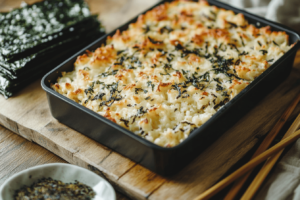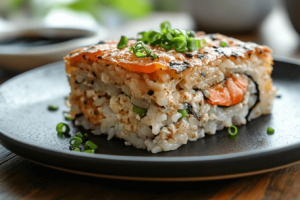Sushi bake has taken the food world by storm. This Japanese-inspired casserole is easy, tasty, and fun to share. Yet many people wonder, “Are you supposed to eat sushi bake hot or cold?” Some enjoy a sizzling casserole fresh from the oven. Others prefer a chilled slice with refreshing toppings. Below, we explore both sides so you can decide which temperature suits your taste. Moreover, we will share tips to perfect your sushi bake. Let’s dive in!
What Is Sushi Bake?
Sushi bake is a delightful casserole-like dish inspired by traditional Japanese sushi. It combines classic components such as rice, fish or shellfish, and savory seasonings. Typically, people layer these ingredients in a baking pan, then top it all with sauces like spicy mayo or a creamy mix. After baking, you get a comforting dish with a warm, rich flavor.
Sushi bake has a unique texture. The top is creamy, the middle is packed with fish, and the base is a soft bed of rice. It often includes ingredients like salmon, imitation crab, or shrimp. Furthermore, seaweed is served on the side to wrap small bites of the bake, mimicking the hand-rolled sushi experience.
Many find it simpler than making individual sushi rolls. Since you cook it in one dish, you avoid delicate rolling steps. Additionally, it is easy to customize. You can add vegetables or play with sauces to match your mood.
But why the debate around eating it hot or cold? Some argue that sushi is traditionally served chilled, while a “bake” is usually served warm. Next, we will compare each side so you can pick your favorite way to enjoy this comforting meal.
Hot or Cold Sushi Bake: Are You Supposed to Eat Sushi Bake Hot or Cold?
This question arises because sushi bake is a fusion of classic sushi ingredients and a baked casserole style. Traditionally, sushi is served cool or at room temperature. In contrast, a casserole is typically hot, just out of the oven. Hence, we have two common approaches:
- Hot sushi bake: People prefer this when they want a gooey, fresh-from-the-oven treat with melted toppings and a crispy, golden crust.
- Cold sushi bake: Others enjoy letting it rest until it cools, relishing the subtle flavors of fish, sauce, and seaweed without heat dominating the taste.
-
A slice of sushi bake ready to enjoy.
But which way is correct? There is no official rule. Most recipes guide you to serve it warm. However, if you let it cool or chill it in the fridge, you get a different flavor profile that some find refreshing. Let us explore why you might choose one temperature over the other.
Why Choose a Hot Sushi Bake?
Many people love warm comfort foods. A hot sushi bake provides a cozy meal similar to many classic casseroles. Furthermore, the heat intensifies certain flavors. The mayonnaise topping becomes toasty, and the fish or shellfish stays succulent. Here are some top reasons to eat sushi bake hot:
- Enhanced texture: Heat creates a slight crisp on top, which contrasts with the soft rice below.
- Melty toppings: Sauces and cheese (if added) blend smoothly. They coat each bite with savory goodness.
- Appetizing aroma: Warm seafood and creamy condiments release a mouthwatering scent that excites the appetite.
- Comfort factor: Many prefer hot meals because they offer that soothing sensation we often seek in hearty dishes.
Additionally, a hot sushi bake can easily become the star of your potluck table. It travels well, and you can reheat it before serving. Therefore, if you like your meals piping hot, serving sushi bake right out of the oven is a great choice.
Why Some People Like It Cold
On the other hand, cold sushi bake has its own charm. Although it starts out hot from the oven, letting it cool changes the flavor and texture. Because it includes sushi components like rice, fish, and seaweed, it can taste similar to chilled sushi rolls. Moreover, some argue that cooler temperatures bring out the subtle taste of each ingredient. Here are a few reasons to consider cold sushi bake:
- Refreshing bite: Cold sushi bake can feel lighter, especially on a warm day.
- Balanced flavors: When not heated, the flavors of seafood and sauces mingle in a calmer way, making them less intense and more nuanced.
- Easy to store: If you have leftovers, it is simple to keep them in the fridge. You can enjoy a slice without reheating.
- Ideal for meal prepping: Some find it easier to bake a large dish and portion it out for lunches or quick snacks. Eating it cold is convenient if you do not have access to a microwave or oven.
Still, there are a few practical steps to keep in mind when storing and eating sushi bake cold. You want to ensure food safety. Additionally, you may need to reduce the time it sits out at room temperature. That way, you keep everything fresh and tasty.
Warm or Cold: Finding Your Perfect Sushi Bake Temperature
Your choice depends on personal preference. Some people swear by the piping-hot version, while others think chilled sushi bake is the best. Still, you might be curious to try both. Below are some tips to help you make your own decision:
- Texture preference: If you like crispy, gooey layers, opt for a hot bake. If you enjoy firm rice and delicate seafood flavors, consider a cold slice.
- Occasion: A hot dish often fits a dinner party, while a cold version might be simpler for a quick lunch.
- Toppings: If you add cheese or a mayo-based sauce, serving it hot can be extra indulgent. If your dish has fresh toppings like cucumber slices, you might enjoy the crisp chill.
- Experimentation: Perhaps try a bit hot, then let a portion cool. This approach helps you see which one you prefer.
In truth, both methods yield delicious results. Sushi bake is versatile, so you get to decide how to serve it based on your taste. Transitioning from hot to cold is also simple. You can enjoy it warm on the first day and chilled on the next if there are leftovers.
Basic Ingredients You Need
Whether you eat it hot or cold, you need a few key items:
- Rice: Sushi rice is ideal because it has a stickier texture. It holds up better when layered.
- Seafood: Imitation crab, salmon, or shrimp are popular choices. Mix them for a seafood medley.
- Sauces: Spicy mayo or Sriracha mayo provides creaminess and a hint of heat. You might also use unagi sauce for a sweet note.
- Seasonings: Furikake (a Japanese seasoning blend) is key. It often includes sesame seeds, seaweed flakes, and more.
- Optional extras: Vegetables like diced onions or bell peppers can add extra texture. Adding cheese or a creamy sauce is also popular in certain variations.
For a more traditional sushi vibe, stick to basic sushi rice, crab, mayonnaise, and furikake. Yet, for a bold twist, add spicy tuna or salmon. Alternatively, you can incorporate crisp toppings like tempura flakes for more crunch.
Step-by-Step Guide to Making Your Own Sushi Bake
While the temperature is crucial, you can adapt the recipe to your liking. Here is a simple process:
- Cook the rice: Rinse sushi rice until the water runs clear. Cook it in a rice cooker or on the stovetop. Use the same technique as for regular sushi rice. When done, mix in a touch of rice vinegar, salt, and a pinch of sugar. This helps flavor the base.
- Prepare seafood: If using imitation crab, shred it. If using cooked salmon, flake it. If using shrimp, chop it. Combine seafood with mayonnaise and a bit of Sriracha if you like spice.
- Layer in a baking dish: Spread the rice on the bottom. Sprinkle furikake over the rice layer. Next, spoon the seafood mixture on top of the rice.
- Add toppings: Drizzle spicy mayo on top or even add shredded cheese if you like a richer dish. You can also sprinkle more furikake or sesame seeds.
- Bake: Place the dish in a preheated oven at about 375°F (190°C) for 15 to 20 minutes. The top should look slightly golden.
- Serve: Offer roasted seaweed sheets on the side. Diners can scoop a portion of the sushi bake and wrap it in seaweed to eat like a hand roll. Enjoy it right away for a hot version or let it cool for a chilled approach.
Moreover, you can store leftovers in an airtight container in the fridge. This leftover portion is perfect for cold sushi bake if you want to try it another way.
Popular Variations to Consider
Sushi bake is incredibly flexible. If you like variety, here are a few fun spins you can try:
- Spicy tuna: Mix chopped tuna with spicy mayo, green onions, and a splash of soy sauce.
- Salmon and cream cheese: This nods to a classic bagel and lox combo, but in a sushi bake form. Add dill or capers for extra flair.
- Vegetarian: Swap seafood for tofu or roasted veggies. Add a drizzle of teriyaki sauce to keep it savory.
- Shrimp tempura: Layer crispy shrimp under your sauce. Bake only long enough to warm through.
- Avocado: Dice fresh avocado and add it after baking for a cool, creamy contrast.
Additionally, feel free to pair it with side dishes. Miso soup or a light salad can round out the meal. Likewise, pickled ginger adds brightness between bites. Be creative and discover new combinations you love.
Serving Tips for the Best Experience
Once your sushi bake is ready, you want to enjoy it to the fullest. Whether hot or cold, here are some practical serving tips:

- Use seaweed sheets: Keep them in a separate dish so they stay crisp. Guests can pick them up, scoop a bit of sushi bake, and enjoy each bite.
- Offer extra sauces: Place small bowls of soy sauce or wasabi on the table. Diners can add extra flavor as desired.
- Garnish: Top each portion with sliced green onions or a drizzle of unagi sauce. Small touches make a big impact on presentation.
- Slice it: If you plan to eat it cold, let it chill in the fridge. Then, cut neat squares or rectangles. This makes serving a breeze.
- Keep it safe: Store leftovers in a sealed container. Eat them within two days for best freshness.
Furthermore, do not forget to keep surfaces clean. Food safety is crucial when dealing with seafood. By taking simple steps, you can savor each bite without worry.
Balancing Flavor and Texture
Heat affects the taste and texture of sushi bake. When the dish is hot, the flavors meld together. You get a creamy, savory bite that is more pronounced. Conversely, when it is cold, each ingredient stands out. The rice is firmer, and the seafood has a milder flavor. This stark difference intrigues many fans of sushi bake.
You could also try a middle ground: let the dish come to room temperature. That approach brings softness without intense heat. It might be ideal if you prefer not-too-hot or not-too-cold foods. Furthermore, consider which sauce or topping you use. Spicy sauces often taste bolder when warm. Sweet or mild sauces can be just as delicious when chilled.
Finally, do not forget the role of garnishes and side dishes. In a hot sushi bake, crispy onions or sesame seeds add texture. In a cold version, fresh cucumber or avocado might highlight the refreshing aspects of the meal. Experiment to create a dish that feels balanced and satisfying.
How to Store and Reheat Sushi Bake
Storing your sushi bake properly is key to enjoying it cold or reheated:

- Refrigeration: Wrap or cover the dish tightly to keep air out. Place it in the fridge. This slows bacterial growth and preserves the taste.
- Timing: Try to refrigerate leftovers within two hours of cooking. This helps maintain freshness.
- Reheating: For a hot version, preheat your oven to 350°F (175°C). Cover the bake with foil to prevent it from drying out. Heat for about 10 to 15 minutes. You can also use a microwave, but be careful not to overcook the seafood.
- Cold consumption: If you plan to eat it chilled, serve it straight from the fridge. You can add fresh toppings, like green onions or sesame seeds, right before serving.
In addition, keep an eye on how long it stays in your fridge. Seafood does not last as long as some other proteins. Generally, it is best to enjoy your sushi bake within two days. Ultimately, proper storage and reheating methods will keep your dish safe and delicious.
Frequently Asked Questions
Should I microwave sushi or eat it cold?
Microwaving is quick if you want a warm bite. However, you risk overcooking the fish or drying out the rice. Many enjoy sushi bake cold because it offers a firmer texture and subtle flavors.
How to warm up sushi bake?
Place your leftover sushi bake in an oven at 350°F (175°C) for about 10 to 15 minutes. Cover it with foil to lock in moisture. You can also pop it in a microwave for a short time, but watch it closely.
Should sushi be eaten hot or cold?
Traditional sushi is eaten cool or at room temperature. Yet sushi bake is a fusion dish, so people enjoy it hot from the oven or cold from the fridge. It depends on personal preference.
Do you eat sushi bake hot or cold?
You can serve it either way! Most people eat it hot first. Leftovers taste great chilled the next day. Try both and see which you prefer.
Conclusion
Sushi bake is a versatile dish that blends the flavors of sushi with the comfort of a casserole. While many like it hot for the toasty, gooey texture, others enjoy it cold for a fresh, firm bite. Your choice should reflect your personal taste or the occasion. Moreover, it is easy to experiment: start hot and save leftovers for a chilly snack later. In the end, sushi bake is all about fun and flavor. So create your own version, share it with friends, and decide for yourself if you prefer it hot or cold. Enjoy every delicious bite!


